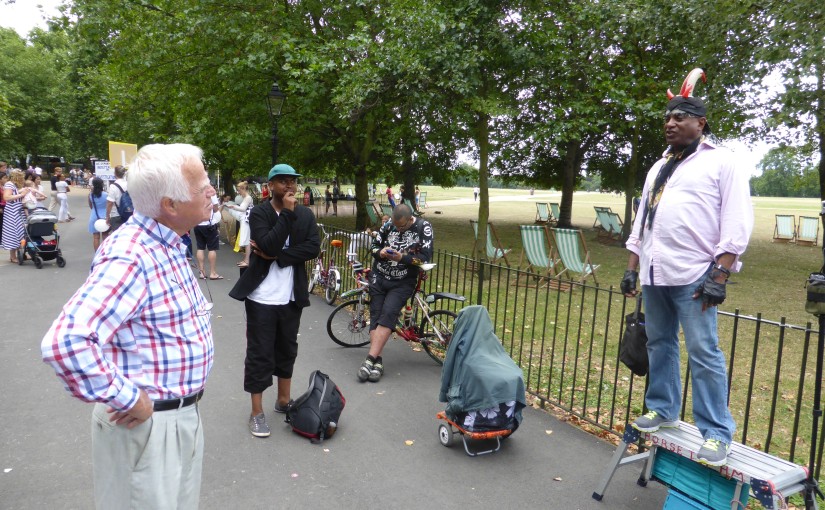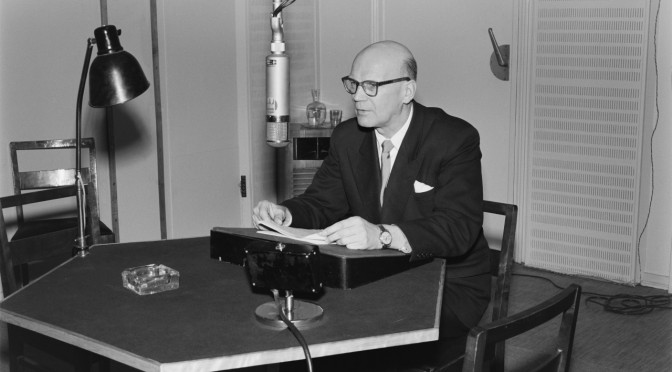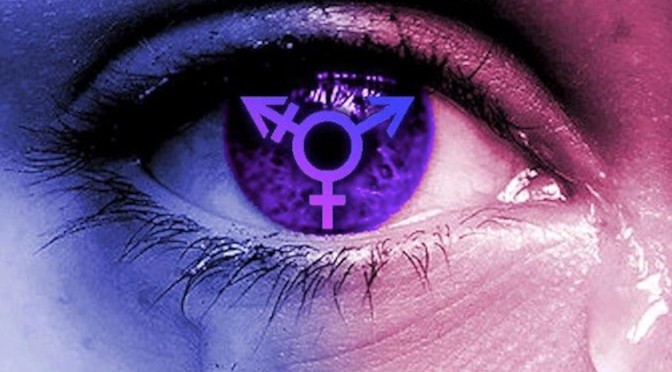Buckle up. This is going to be a long one.
Rewind 100 years. Homosexuality is considered to be a mental disorder and/or crime. The now-obsolete term transvestite has only recently been coined, and transvestites are generally presumed to be homosexual. Any behavior seen as potentially homosexual is illegal, and public persecution is widespread and tolerated. When the medical establishment gets involved at all, treatments range from drugged incarceration to electroconvulsive therapy to lobotomy. A German physician named Harry Benjamin emigrates to the United States and sets up a private practice in New York
A couple of world wars come and go. Dr. Benjamin’s practice is thriving. He has developed expertise in the field of endocrinology, particularly using sex hormones to treat symptoms of aging. He comes into contact with Alfred Kinsey, who refers to him a young patient born male but with an unshakable desire to become female. Up to this time (1948), tranvestism is mostly seen as a fetishistic condition of adults. Neither Kinsey nor Benjamin think that this explains the child’s behavior. Benjamin treats the child with estrogen and his dysphoric symptoms ease. He sends the child to Germany where surgical techniques for transsexuality are maturing.
Similar patients follow. Benjamin develops a reputation for treating transsexuals (a term he popularized, if not invented) with compassion and sympathy–a welcome change within the culture of the time. He networks with psychologists and surgeons and catapults into the public eye as physician to Christine Jorgensen, the first widely-known recipient of sex reassignment surgery. More patients, publications and research follow.
In 1979, an international group of psychologists form the Harry Benjamin International Gender Dysphoria Association to develop standards of care for the treatment of patients with gender identity disorder (since renamed gender dysphoria). Harry, now 94, consents to the honor. In 2007, it renames itself the World Professional Association for Transgender Health (WPATH). Their Standards of Care (SOC) form the basis for all that follows in this post.
With our history lesson firmly in hand, I now move on to treatments for transsexuality. Nevertheless, I must pause momentarily to talk about what does not work:
Psychotherapy aimed at changing gender identity and/or sexual orientation. This was the realization that drove Benjamin’s work. He found that dealing with the mind/body tension of transsexuality by trying to change the mind was dreadfully ineffective, and reasoned that it would be far easier to change the body instead. The success of his methods and public notoriety brought on by Christine Jorgensen fueled funding and research questions which ultimately ended up vindicating this approach.
Conversion (“reparative”) therapy. This might sound like the same thing, but the motivation and methodology is so draconian that it requires separate mention. Reparative therapy continues to be touted by religious groups as an effective and biblical approach to homosexuality and transgenderism. I’ll leave judgments about how biblical it is up to you, but the questions of efficacy are easily addressed. It doesn’t work. Studies claiming to support the success of reparative therapy are plagued by high rates of participant dropout, short follow up times and false equivalences drawn between decreased homosexual arousal and actual conversion to heterosexuality. In other words, through harsh shaming, indoctrination of the idea that God doesn’t want you to be LGBT, and in many cases, frank physical torture–aversion therapy–reparative therapy might (but probably won’t) make you asexual. It will not make you straight. The largest reparative therapy organization in the country, Exodus International, stopped their ministry in 2013, admitted that their program did not work and apologized to the LGBT community. Nevertheless, other organizations are picking up the banner and soldiering on.
I did not undergo reparative therapy, but I can personally attest that more than two decades of earnest religiously-motivated efforts to “straighten up” did nothing to shake the girl out of me. It did, however, help make me become a miserable prick. My own methods consisted of prayer–increasingly desperate pleading for deliverance–bible study, humiliating confession (first to Kathy, then to anonymous souls on the nascent internet, and decades later to friends), and traditional practices of spiritual discipline, particularly meditation and fasting. Throughout this process, my gender dysphoria became worse, not better, until I eventually scared myself, waking up one morning to realize that my frequent fasting had driven my weight down to 159 pounds. I am 6’3″. Even this didn’t squelch my motivation. On my first visit to a psychologist (which felt like a defection for me), I laid out how I had tried and failed to break free from transgenderism, and that I realized it wasn’t working. I needed a new approach. She basically said that she couldn’t offer any cure, but that I was welcome to stick around if I wanted help in dealing with being trans.
I’ll let you know if this new direction ultimately results in my sanity. If nothing else, I can certainly attest that my life has changed dramatically, mostly for the better. Now, without further ado, here are the treatment options for transsexuals:
1. Mental health services. Trained therapists can help identify gender dysphoria and possible co-existing mental illness. Psychotherapy is offered, but is not strictly speaking required for gender transition. Therapists work to control co-existing illness (e.g. depression, anxiety, PTSD, chemical dependence) if present, and lay out the medical options for gender change. While the therapist can work with the patient to understand and choose options, the choice emphatically rests with the patient.
2. Hormonal therapy. Appropriate and interested patients are referred to an experienced physician (often, but not always an endocrinologist) to consider cross-hormone therapy. A risk/benefit discussion takes place, and further medical testing may occur to predict risk. The principle risks of masculinizing hormones are osteoporosis, cardiovascular disease, hypertension, slight increase risk of ovarian and endometrial cancers and psychological symptoms including manic behavior and aggressively. FTM’s need ongoing screening including pap smears and mammography if they do not undergo hysterectomy and/or mastectomy respectively. The principal risks of feminizing hormonal therapy include blood clots, cardiovascular disease in patients with associated risk, hypertension and loss of libido. Feminizing hormones do not cause breast cancer in MTF’s and may alleviate prostate cancer risk, although prostate screening is still necessary even after full medical and surgical transition.
It all sounds rather scary, does it not? Why would anyone consider this? In a nutshell, it works.
Cross-sex hormonal therapy appears to be effective treatment for gender dysphoria. We tend to think about this backwards in light of what I described last post as our societal genital fixation. We suppose, “Tom (formerly Tammy) wanted to have muscles and a low voice. Now he has them. Tom is happy.” Or, Tammy (formerly Tom) wanted breasts and a bigger booty. Now she has them. Tammy is happy.” While I don’t deny at all that physical changes which allow a person to move more comfortably through our gender binary society can and do promote happiness, we risk missing the main benefit. Increasingly it is becoming clear that the brain is a primary target for hormonal therapy, not merely the beneficiary of external physical changes. Hormones change the way we think–something no parent of a teenager would ever deny–and these changes can potentially be harnessed for the benefit of those who deal with gender dysphoria.
Cross-sex hormones cause the patient to express traits that are already present in their DNA. Their bodies come to more closely resemble that of their male (FTM) or female (MTF) relatives. Hormonal therapy is particularly effective for FTM transsexuals. They experience increase in muscle mass, deepening of the voice growth of body hair, male pattern hairline (baldness if they carry the genes) and often increased libido. Testosterone will not increase their skeleton size or cause them to grow a penis, but they will experience clitoral enlargement and, unfortunately, vaginal dryness. Fat redistributes from the chest, buttocks, arms and legs to the abdomen. They go through menopause and a second puberty, complete with acne. There are pluses and minuses, obviously, but the final result is someone who convincingly looks and sounds like a genetic male, albeit one with shorter/small limbs, wider hips and breasts. With chest binding or surgery, you walk right past FTM’s without noticing.
MTF patients experience somewhat less convincing physical changes. Hair loss stops, but hair does not regrow. Body hair thins and softens, but facial hair remains. Muscle mass decreases and fat redistributes to the hips and chest. Some breast development occurs. The voice does not change. Testicular volume decreases and libido often does as well. Skeletal structure is unchanged including facial structure. The skin softens, but again, a puberty-like display of acne is typical. The visual end result is a tall, large-framed, masculine-jawed woman with small breasts and a masculine pelvis. Some transwomen “pass as women,” but many do not.
These changes start in a couple of months and develop over a couple of years. As I mentioned early in this series, hormonal therapy prior to onset of puberty achieves results that are cosmetically remarkable. Recall the picture of Nicole Maines and her identical twin brother. The Standards of Care from WPATH apply to persons of the age of majority, but there are also guidelines for minors with parental involvement/consent.
One more detour to the top of the old soap box before proceeding on to transsexual surgery, which I suppose is the juicy bit that has kept you reading thus far. Hormonal therapy is quite common. Cross-sex hormone therapy is quite common. My grandfather took estrogen for decades to slow the progress of prostate cancer. It worked. I can think of a half dozen other people (outside the context of work) off the top of my head who are taking or have taken cross-sex hormones to thwart one disease process or another. Beyond that, millions of Americans take sex hormones to promote well being through and beyond mid life for that which is not even a disease–aging. We certainly knew about menopause before hormone therapy. Now we have andropause too. People take hormones for a variety of reasons, ranging from life-saving to wellness-promoting. They do this to live longer and better–to make their bodies more habitable–and no one seems to get too knotted about them “screwing with nature.” Transgender people deserve nothing less than the same respect.
3. Transsexual surgery. There is no such thing as “The Surgery”. That expression derives from societal fixation on male genitalia. Dozens of procedures that would qualify as transsexual surgeries. Here, the results are opposite what we saw with hormonal therapy–treatment is more effective for MTF’s than FTM’s. The transsexual catchphrase here is, “It’s easier to dig a hole than to build a pole.”
Construction of a functional penis from spare parts does is not yet within our technological grasp. Last week’s news of a successful penis transplant may offer hope for the future, but for now options are limited. Phalloplasty involves creation of a penis from a combination of genital skin and a muscular flap taken from the chest, abdomen or forearm. The result may be cosmetically satisfying but cannot become erect. Mechanical implants can be added to simulate natural erection. Research is underway to grow erectile tissue in the lab. Other common surgical options for women include hysterectomy, oophorectomy (removal of the ovaries), and as mentioned above, mastectomy. MTF lingo refers to these procedures colloquially as top (breast) and bottom (genital) surgery.
A variety of surgical options exist for MTF’s as well. Vaginoplasty consists of removing the spongy, erectile tissue out of the penis, then inverting the penis to form a cavity. The tip of the penis is used to form a clitoris. Multiple different techniques have been developed. In some, the result is a dry neo-vagina that requires lubrication, but does not involve surgical entry of the abdomen. Others choose to have a small ring of intestinal tissue rotated down and incorporated into the vagina. The intestinal ring continues to produce mucus, which lubricates the vagina. Unfortunately, it never stops doing so, so it’s always a bit wet and sloppy down there, which trans-activist Kate Bornstein has quipped “isn’t necessarily a bad thing.” Whichever technique is chosen, the results can be cosmetically remarkable–“good enough to fool your gynecologist” and fully functional sexually (although who the hell knows if transfemale orgasm and female orgasm feel similar). The point is that, once again quoting Kate, “the plumbing works, and so does the electricity.”
Other transsexual surgeries for MTF’s include breast augmentation, facial feminization, tracheal shave (to minimize the laryngeal cartilage or “Adam’s apple”), liposuction/lipocontouring, voice surgery and a variety of cosmetic procedures (e.g. buttock augmentation, I kid you not) which are not unique to transwomen.
4. Voice therapy. Part of the reason I chose Renae for my name is that I anticipated that there would be days when I lacked the energy to explain to an incredulous person on the other end of the phone that they were speaking to a female. A name that allows me to opt out of that conversation is useful in that regard. Still, I suspect that it is my voice, even more than my size that causes people to react to me as male, despite my clearly displayed preferences to the contrary. Voice therapy offers transsexuals the most effective means of dealing with this problem.
Testosterone lowers the voice of FTM’s, but estrogen does not raise the voice of MTF’s. I mentioned vocal surgery, but I don’t think it is particularly common. For one, it is quite expensive. Further, as it involves manipulating the vocal chords, there is risk to the airway. In vocal coaching/therapy, MTF’s learn to alter pitch and timbre, as well as to adopt more stereotypically feminine patterns of speech.
5. Hair removal. Testosterone causes body and facial hair to grow in FTM’s, but it does not reverse male pattern hairline/baldness or remove facial hair in MTF’s. Two techniques compete now for MTF hair removal. The tried-and-true solution is electrolysis, which consists of inserting a needle into each hair follicle one by one and discharging an electric shock. This must happen roughly five times per hair (there are thousands), but results in permanent removal. The newer technique involves laser therapy at frequencies that target the growing follicle. This allows for removal of many hairs simultaneously and with less pain. It works best for individuals with light skin and dark hair. The results are not reliably permanent.
Personally, I’ve had a hell of a lot of laser, and a single trial of electrolysis. The laser technician warns you that the laser will feel like the snap of a rubber band against the skin. While this is perfectly true on, say, the back of one’s calf, the sensation on the face, particularly around the mouth more closely resembles someone pushing a lit cigarette against the skin for a 1/2 second. The zap of electrolysis is roughly equivalent, but remember that each zap of the electrologist’s needle corresponds to a single hair. Repeat times 10,000 or so over a multi-year period. Additionally, I found that electrolysis left my skin swollen, and pitted, the latter for more than a year after a single treatment. For the time being, I have chosen to shave the lighter hair that remains post laser, but some regrowth is inevitable if I do nothing else.
6. Legal changes. Alteration of vital documents allows some transgender people to move more comfortably in society. Legal requirements for name and gender change have been rewritten to remove hormonal therapy and/or surgery as prerequisites. I previously blogged on this process here.
The list above is not complete or exhaustive. WPATH recommends that these treatments be made available to qualified patients who experience persistent, significant gender dysphoria, who are competent to give informed consent to the treatment options and who do not have severe psychopathology. Treatment is flexible. Some people opt for none of the treatments, others for all. Still more pick and choose among them. Given that understanding the WPATH standards provide a roadmap for all transgender people, not just those who ultimately go on to surgery. Indeed, the word transsexual itself is just a position on a spectrum of variance, and is already fading into obsolescence.
Whither from here?
In 1974, homosexuality was removed from the DSM, the reference text which lists and defines mental illness. This decision stands as a critical landmark in the advancement of homosexual rights. Will the same thing happen with gender dysphoria?
In some ways, I hope not. What we desire is to be taken as human beings, and to be seen as valuable and whole within the human family. On the other hand, the treatments which offer the most hope for promoting transgender wholeness are irreducibly medical and really, really damned expensive. We can learn only so much from the experience our sisters and brothers in the homosexual community. As Jenny Boylan remarked, gays and transgender folks have very little in common beyond the fact that we get beat up by the same people. We walk a different path, and must do it in our own way.
Kudos. You did it! Thank you for putting in the effort to understand. I have thrown an absolute mess of information at you, so I reiterate my initial offer to ask questions from the medical to the personal at this point. Further, those who made it this far are welcome to claim a prize of either a Human Rights Campaign (= sign) or Be Who You Are sticker until my supplies run out. Let me know.












